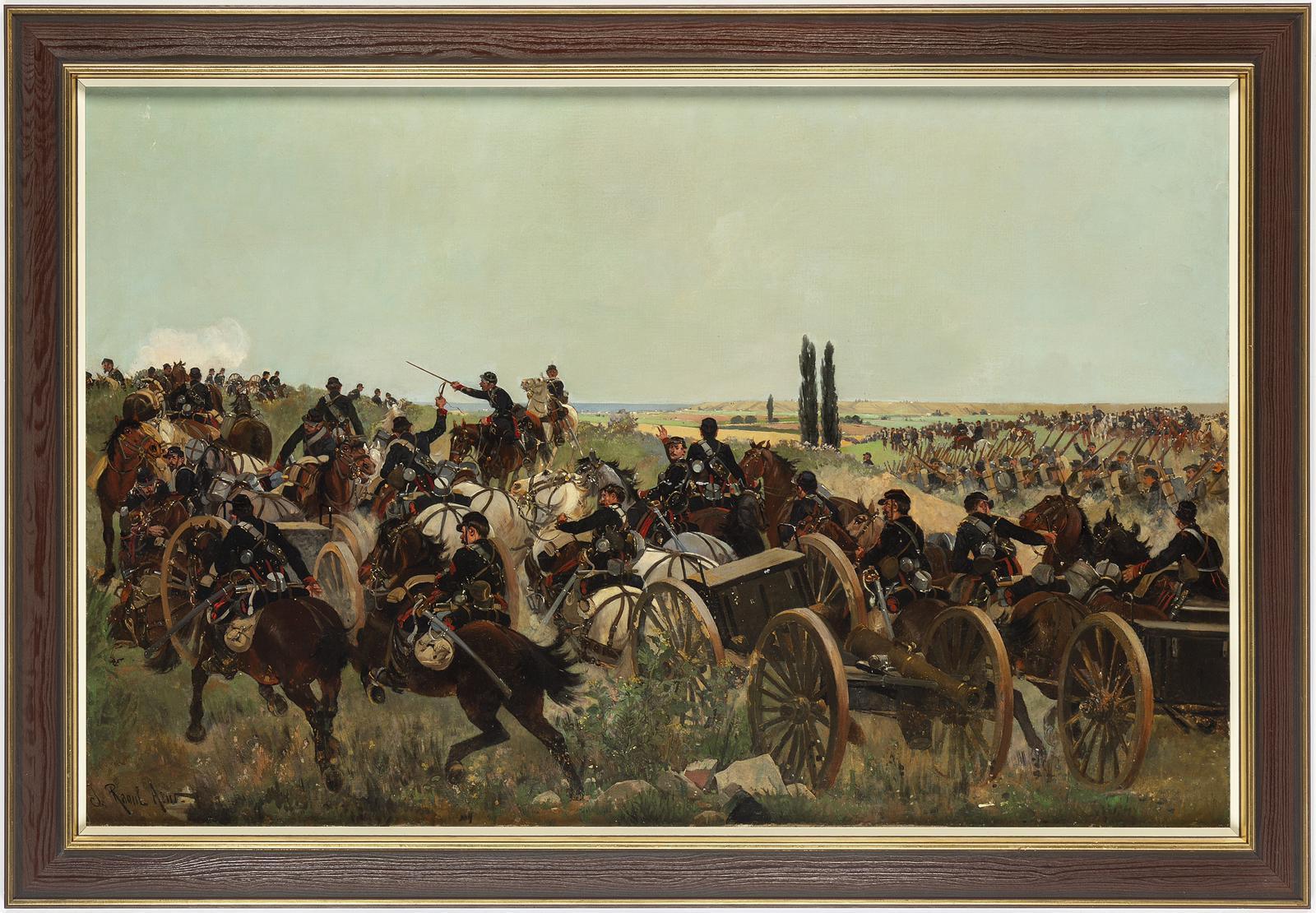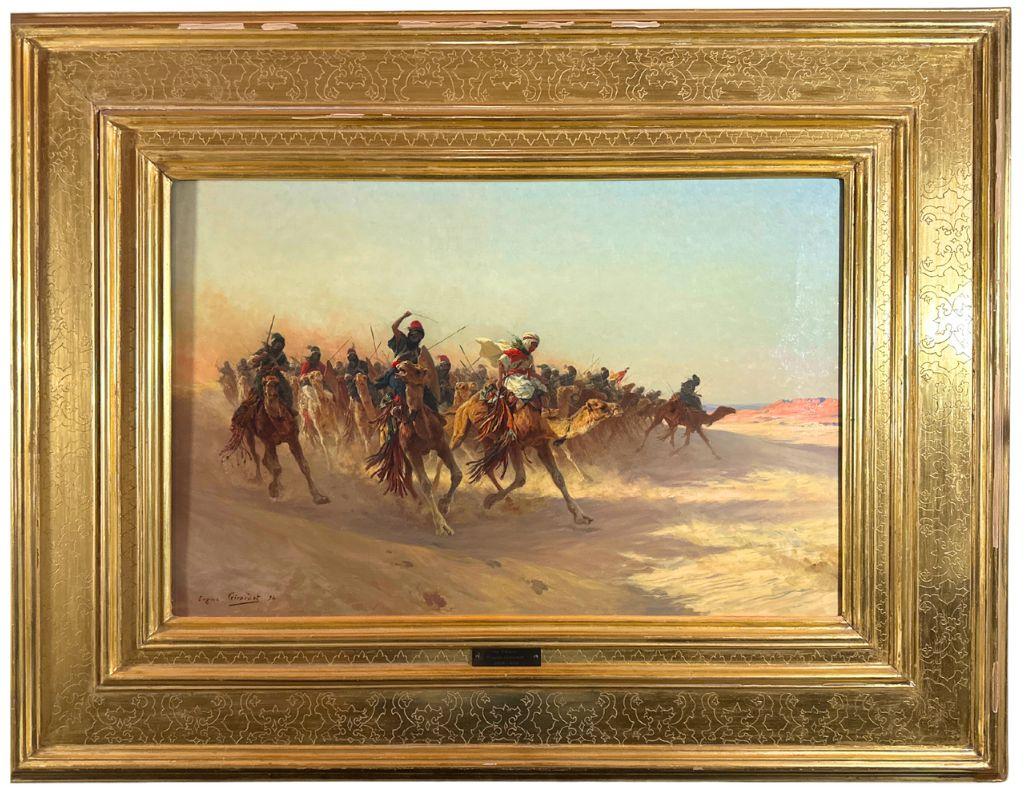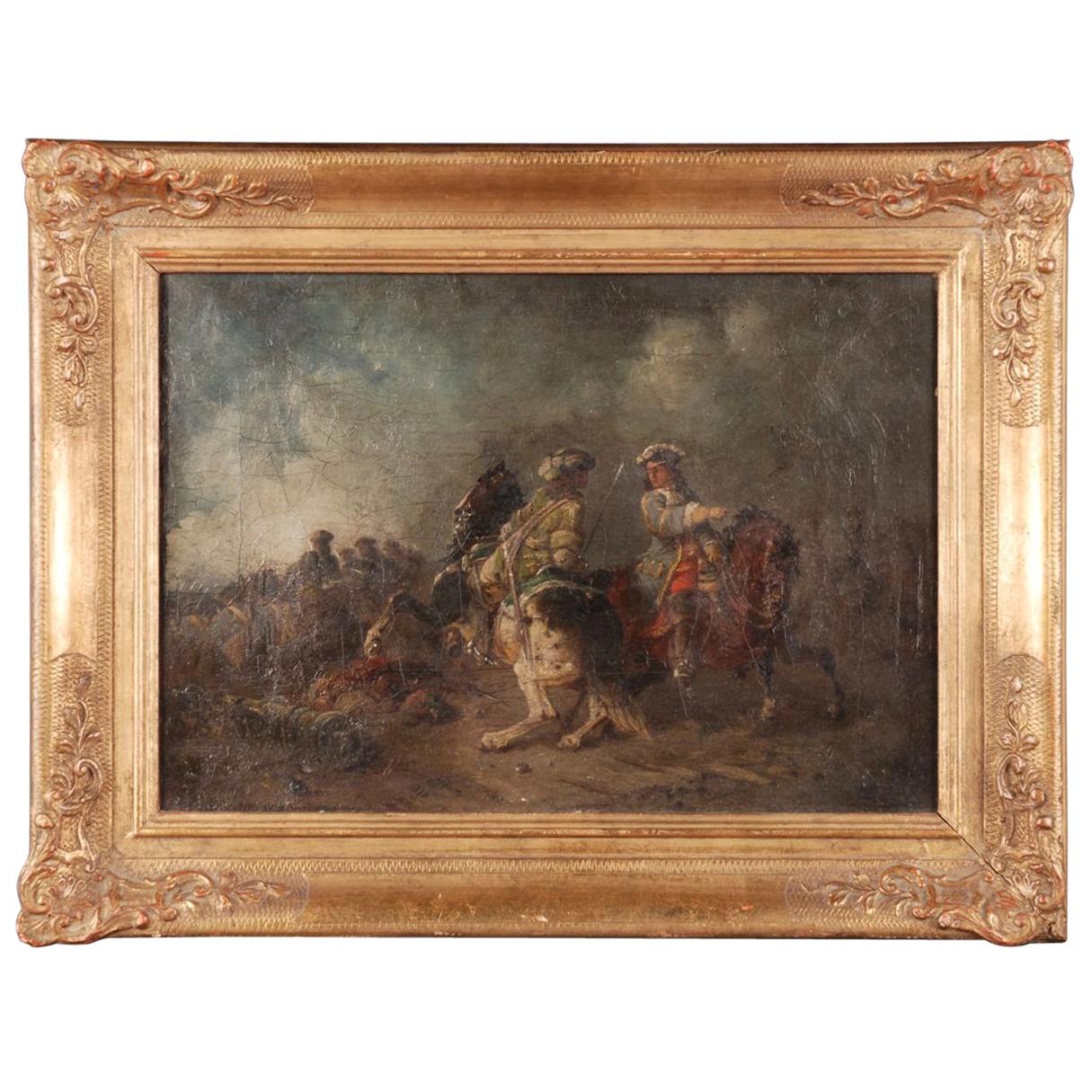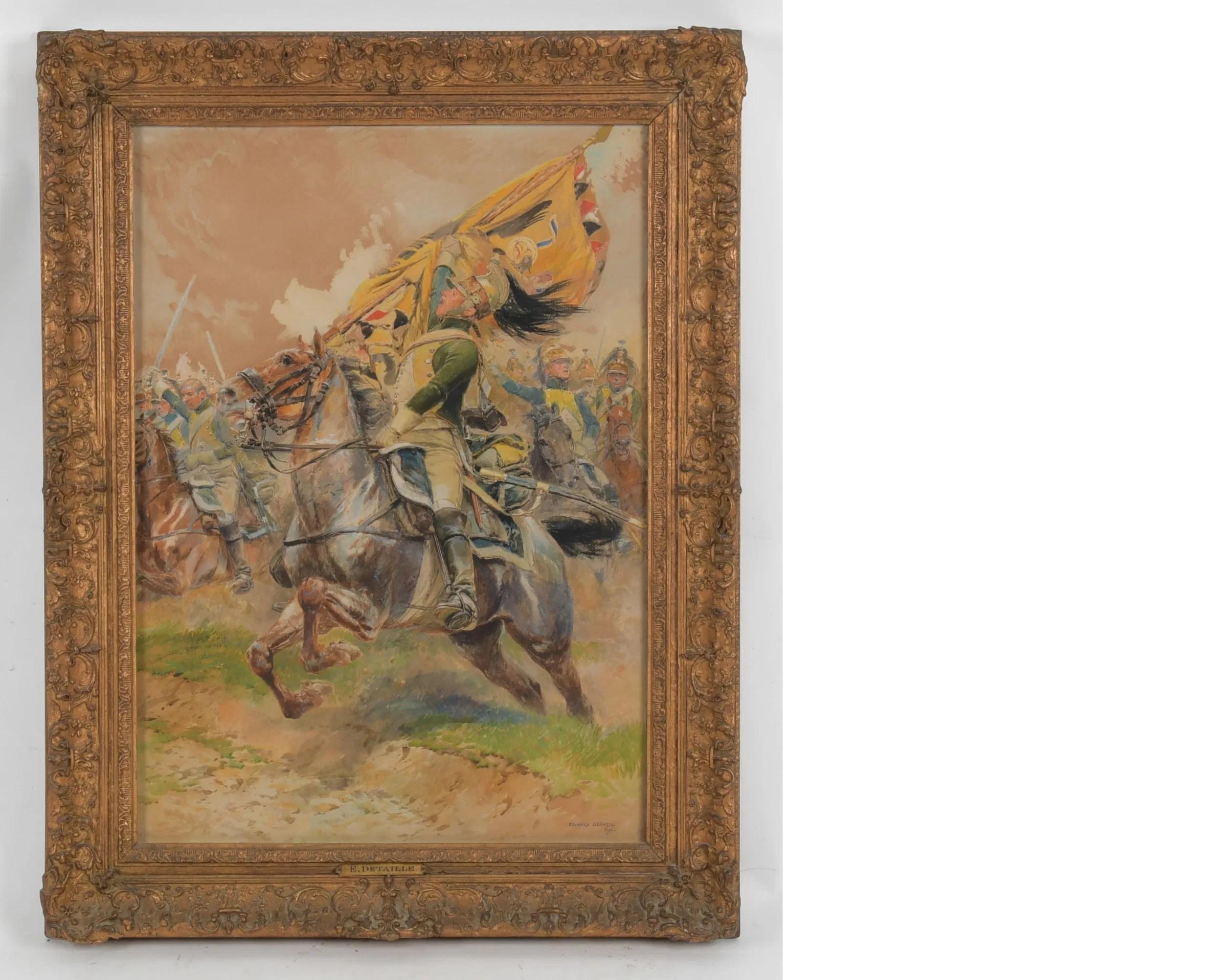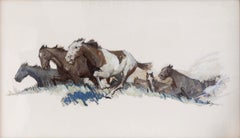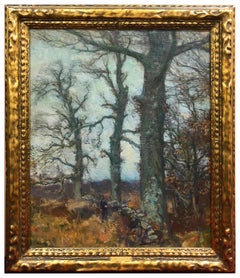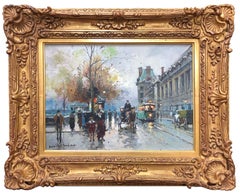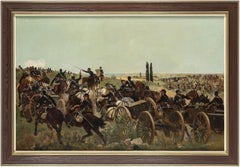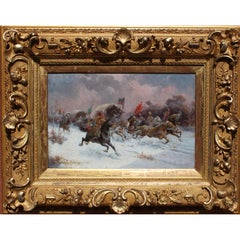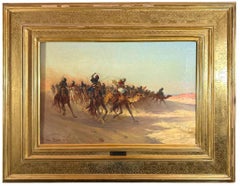Items Similar to Franco-Prussian Battle Scene
Want more images or videos?
Request additional images or videos from the seller
1 of 6
Wilfrid Constant BeauquesneFranco-Prussian Battle Scene
Price Upon Request
Price Upon Request
Price Upon Request
Price Upon Request
Price Upon Request
Price Upon Request
Price Upon Request
Price Upon Request
Price Upon Request
Price Upon Request
About the Item
Wilfrid Constant Beauquesne (1847 - 1913)
"Franco-Prussian Battle Scene" c. 1900
Oil on Canvas
Signed Lower Right
Site Size: approx 22 x 28 inches
Framed Size: approx 35 x 40 inches
French artistry was deeply influenced by three wars during the 19th century and, accordingly, the artistic imagination was not lost upon the public. "Patriotism comes to the aid of battle painters," a contemporary remarked, "presenting them with a sympathetic public already fascinated by the subject." After the brief Franco-Prussian conflict of 1870, French painters were particularly anxious to retrieve national pride by presenting works which reflected their own national heroism versus enemy brutality.
Known for his scenic depictions of this war, Wilfried Beauquesne, a native of Rennes, France, was undoubtedly influenced in his selection of subjects by his instructors at the Ecole des Beaux Arts in Paris. Vernet-Lecomte and Horace Vernet were both well known military artists. Vernet had actually lived and worked during the period of Napoleonic conflicts - being awarded the Legion of Honor by the Emperor's own hand. Beauquesne exhibited regularly at the annual Paris Salon between 1887 and 1899, as well as throughout Europe.
In 1890, illustrating the fortunes of life, The Art Amateur ran the following item in its "Gossip Column:"
"A queer story comes to me from Paris. A commission agent made a bargain with a poor painter, living out at Saint-Maude, to paint military subjects for him, at two francs an hour. The agent changed the signature to that of Gaubault, and sold the pictures to various dealers. On day, by chance, the poor painter came to Paris, went to the Salon, and was astonished to see one of his pictures there. He look at the catalogue, and found the name of the artist and the address of the dealer where he was to be found, The poor artist went to the dealer and introduced himself saying, "I am Gaubault." "Most happy to make your acquaintance," replied the dealer. "Your pictures sell very well, and I have been wanting to see you for the last six years." "But my name is not Gaubault, it is Beauquesne." Explanations followed. The dishonest commission agent disappeared; and Beauquesne restored his real signature on the pictures, which had made his pseudonym almost famous."
Source:
Biography excerpted from the unpublished catalog by Edward P. Bentley for the Haussner Restaurant in Baltimore, Maryland, titled Haussner's: The Art Collection.
- Creator:Wilfrid Constant Beauquesne (1847 - 1913, French)
- Dimensions:Height: 35 in (88.9 cm)Width: 40 in (101.6 cm)Depth: 2 in (5.08 cm)
- Medium:
- Movement & Style:
- Period:
- Condition:
- Gallery Location:Missouri, MO
- Reference Number:1stDibs: LU74733571751
Wilfrid Constant Beauquesne
Wilfrid-Constant Beauquesne was born in Rennes on October 28, 1847, and died at Montgeron on October 9, 1913. He is a French painter. He was a pupil of Horace Vernet and Émile Vernet-Lecomte at the École des Beaux-Arts in Paris. A painter of military scenes, he is mainly known for his paintings on the Franco-German War of 1870. We also owe him the decoration of the chapel of Château de Vincennes.
About the Seller
5.0
Vetted Professional Seller
Every seller passes strict standards for authenticity and reliability
Established in 1970
1stDibs seller since 2017
156 sales on 1stDibs
Typical response time: Several days
- ShippingRetrieving quote...Shipping from: Missouri, MO
- Return Policy
More From This Seller
View AllThe Painted Stallion
By William Henry Dethlef Koerner
Located in Missouri, MO
The Painted Stallion
William Henry Dethlef Koerner (German, American, 1878-1938)
Oil on Panel
Signed Lower Right
Titled Verso
21.5 x 37 inches
26.5 x 42.5 inches with frame
Written ...
Category
Early 20th Century American Modern Landscape Paintings
Materials
Oil, Panel
Gray Brothers
By Charles Harold Davis
Located in Missouri, MO
Charles Harold Davis (1856-1933)
"Gray Brothers"
Oil on Canvas
Signed Lower Left
Canvas Size: 30 x 24 inches
Framed Size: 35 x 30.5 inches
Born in Amesbury, Massachusetts, Charles ...
Category
Late 19th Century American Impressionist Landscape Paintings
Materials
Canvas, Oil
Price Upon Request
Quai de Louvre
By Antoine Blanchard
Located in Missouri, MO
Antoine Blanchard
"Quai de Louvre"
Oil on Canvas
Signed
Canvas Size: approx 13 x 18
Framed Size: approx. 22 x 26
Category
Mid-20th Century Post-Impressionist Landscape Paintings
Materials
Canvas, Oil
Price Upon Request
Boulevard de la Madaleine sous la Neige
By Antoine Blanchard
Located in Missouri, MO
Antoine Blanchard
"Boulevard de la Madeleine sous la Neige"
Oil on Canvas
Signed
Canvas Size: 13 x 18 inches
Framed Size: approx 18 x 23 inches
Antoine Blanchard
French (1910-1988)
Category
Mid-20th Century Impressionist Landscape Paintings
Materials
Canvas, Oil
Price Upon Request
Carriage Ride in the Park
By Constantin Ernest Adolphe Hyacinthe Guys
Located in Missouri, MO
Constantin Guys (1802-1892)
"Carriage Ride in the Park" c. 1860s
Ink and Wash on Paper
Original Labels Verso
Site Size: approx. 8 x 11.5 inches
Framed S...
Category
1860s Realist Figurative Drawings and Watercolors
Materials
Paper, Ink, Watercolor
Made in the Shade
By William Henry Howe
Located in Missouri, MO
William Henry Howe (1846-1929)
"Made in the Shade" 1887
Oil on Canvas
Signed and Dated
Site Size: approx. 14.5 x 21.5 inches
Frames Size: approx. 17.5 x 24.5 inches
Provenance: Private Collection, St. Louis, Missouri thence by descent
William Henry Howe was born in Ravenna, Ohio in 1846. Of him it was written: "In the late nineteenth century no American artist was more thoroughly identified with the painting of cows than William Henry Howe." (Richter 128). In a style that combined Tonalism and Realism, he was a painter of light-filled pastoral landscapes that sometimes had sheep as well as cattle tended by their shepherds and herders.
He began a career as a businessman in St. Louis, and in his mid-thirties, changed course and went to Dusseldorf Germany to study art at the Royal Academy. In 1881, he went to Paris and studied with animal painters Felix Vuillefroy and Otto de Thoren. He also exhibited his work at the Paris Salons and the Paris Universal Exposition of 1889.
Travels in Holland in the 1880s with other artists inspired his interest in pastoral subjects, and during that time he began his cattle paintings...
Category
1880s American Impressionist Animal Paintings
Materials
Canvas, Oil
Price Upon Request
You May Also Like
The French-Prussian War - Oil on Canvas by Raoul Arus - Late 19th Century
Located in Roma, IT
The French-Prussian War is an original modern artwork realized by the French painter Raoul-Joseph Arus in the last decades of the XIX Century.
Original Oil painting on Canvas.
Hand...
Category
Late 19th Century Figurative Paintings
Materials
Canvas, Oil
A Fine Austrian/Russian Oil on Board "Charging Cossack Warriors on Horseback"
Located in LA, CA
Adolf Constantin Baumgartner Stoiloff (Austrian/Russian, 1850-1924) a fine oil on board "Charging Cossack Warriors on Horseback" ...
Category
Late 19th Century Baroque Figurative Paintings
Materials
Gold Leaf
Antique French Oil Painting Army Cavarly Soldier Horse Military Despatch Bearer
By Wilfrid Constant Beauquesne
Located in Portland, OR
A fine antique oil painting by Wilfred Constant Beauquesne (1847-1913), of a French cavalry soldier on horseback, 1883.
The painting titled "The Despatch Bearer", depicts a French cavalry soldier riding his horse frantically to deliver despatches to the front. The soldier in full uniform with his cavalry trooper's sword hanging from his sadle & the horse hair from his Cuirassier helmet...
Category
1880s Impressionist Figurative Paintings
Materials
Oil, Panel
The Charge 19th-century Realism Antique Oil Painting on Canvas, Signed
By Eugene Alexis Girardet
Located in Jacksonville, FL
The painting is signed and dated 1894
Description:
Eugene Alexis Girardet (1853-1907) was a prominent Swiss painter known for his remarkable attention to detail and his ability to capture vivid and dynamic scenes. Born in Paris, France, Girardet came from a family of artists and received early artistic training from his father, Paul Girardet, and his uncle, Jules Girardet, both respected engravers. He later studied at the prestigious École des Beaux-Arts in Paris, where he honed his skills and developed a deep appreciation for historical and orientalist subjects.
He was interred at the Père-Lachaise Cemetery. In addition to several museums in France, his works may be seen at the Dahesh Museum of Art and the National Museum of Fine Arts of Algiers, as well as at museums in Switzerland and New York City.
Girardet’s artwork often depicted historical and exotic scenes, particularly focusing on Middle Eastern and North African themes. His meticulous attention to detail and his ability to convey a sense of movement and drama made his works highly sought after. One of his most renowned paintings, “The Charge,” exemplifies his exceptional talent and his ability to create a captivating and immersive experience for viewers.
In “The Charge,” Girardet presents an army of Arab camel...
Category
19th Century Academic Figurative Paintings
Materials
Canvas, Oil
19th Century Oil Painting Battle Scene from Adam Eugen
By Eugen Adam
Located in Berlin, DE
Oil painting battle scene of Adam Eugen (1817-1880).
Oil on canvas. Military scene from the time of the Spanish War of Succession, signed and dated Eugen ...
Category
Antique 19th Century German Baroque Paintings
Materials
Canvas
Cavalry Charge 1st Empire - Edouard Detaille - French art
By Jean Baptiste Édouard Detaille
Located in PARIS, FR
Conditions : Very good original Conditions including a beautiful frame. Framed under glass, this rare composition for sale is an exceptionnel piece for Art collectors.
Signed and d...
Category
Late 19th Century Academic Landscape Paintings
Materials
Tempera
